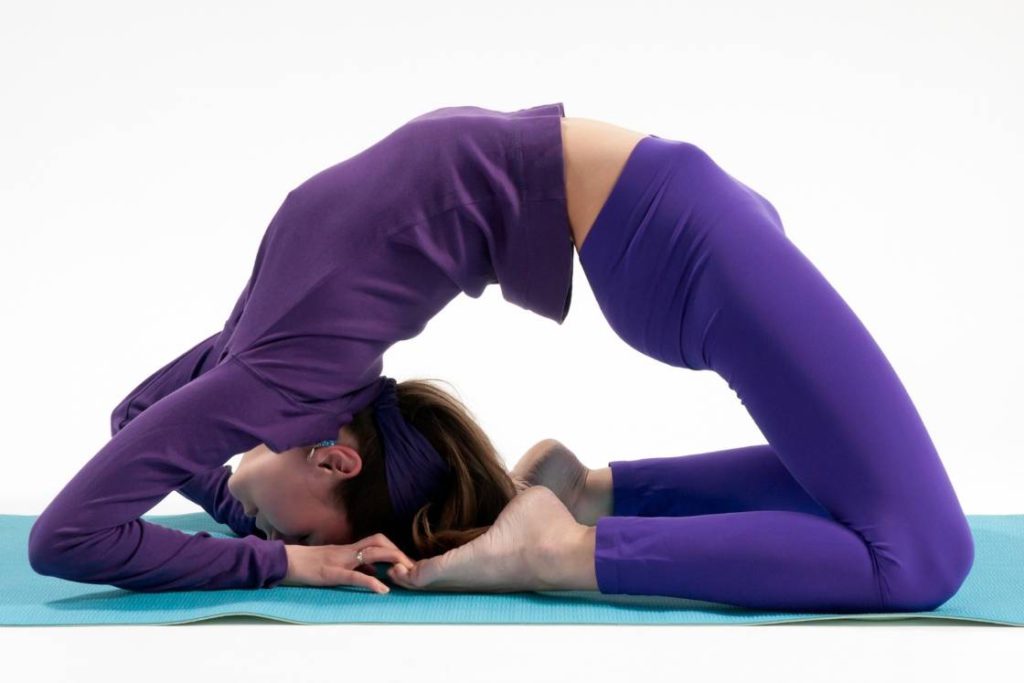
Vajra kapotasana is a graceful back bending posture. It is an advanced asana of the Ashtanga Yoga series in terms of the strength and flexibility required to get into this pose.
It is performed sitting in Vajrasana with hands by the sides. It is followed by bending backward arching the back and dropping the head. The hands are extended over the head with palms pressing the floor and the torso remains lifted.
Practicing vajra kapotasana brings numerous health benefits. The spinal cord and the hip flexors are the major target organs. Besides these, there are numerous therapeutic applications to this posture.
Vajra Kapotasana Meaning
In Sanskrit “vajra” refers to ‘thunderbolt’, “kapota” means “dove” or “pigeon”, and “asana” is “pose”. From the simple thunderbolt posture, the body is folded backward raising the chest and torso. This resembles a graceful posture of a dove, hence the name.
Vajra Kapotasana Practice Guide
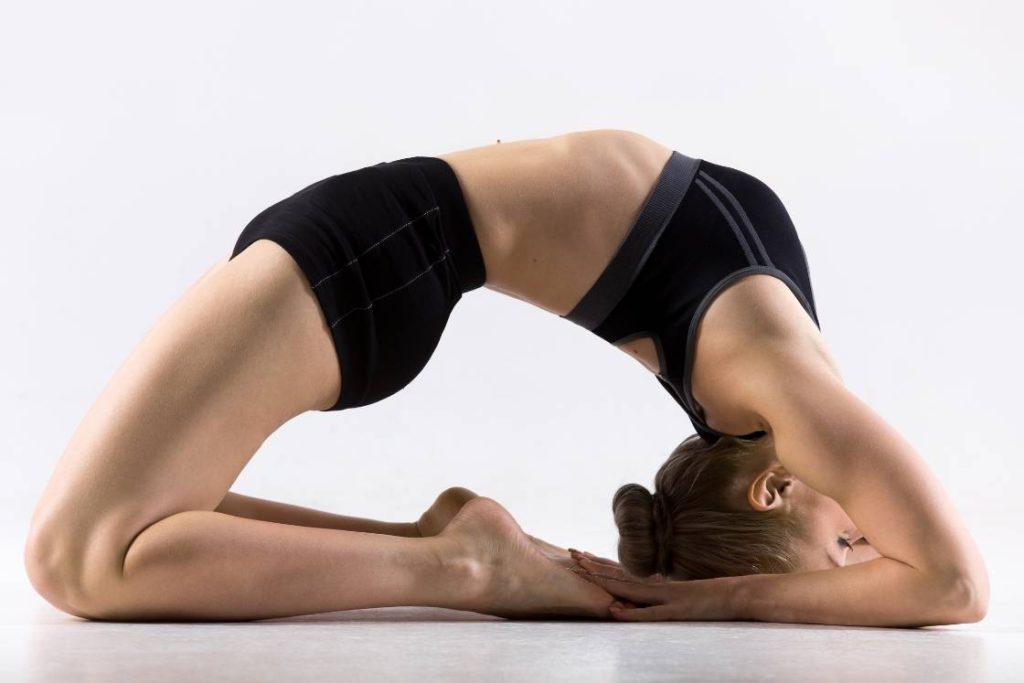
Before getting into the pose the following guide is there for you to follow and know the dos and don’ts.
Contraindications
- Do not go for this pose if have an injury in the neck or lower back.
- It is not suitable to perform this pose with an issue in the knees.
- People suffering from insomnia should not try vajra kapotasana.
- Avoid its practice if you have migraines or hypertension.
- Do not attempt vajra kapotasana in case of a herniated disk.
Preparatory Poses
- Reclining Thunderbolt Pose (Supta Vajrasana)
- Bow Pose (Dhanurasana)
- One-footed King Pigeon Pose (Eka Pada Rajakapotasana)
- Wheel Pose (Chakrasana)
- Cobra Pose (Bhujangasana)
- Thunderbolt Pose (Vajrasana)
How To Do Dove Pose (Steps)
- Begin with sitting in Vajrasana.
- Lean on your back bringing the palms to the legs.
- Raise your arms and place your palms near your ears with fingers pointing towards the shoulders and bent elbows.
- Exhale shifting the weight to the palms.
- Stretching the arms lift the body keeping the knees to the floor.
- Further, stretch the spine and hold the toes with hands bending the elbows.
- Leaning further bring the elbows to the floor. Here, support your backbend position on the forearms.
- Stay there for a few quick breaths.
- With exhalation raise the pelvic region and gradually walk your palms towards the heels.
- Simultaneously draw your head to rest on the soles of the feet.
- Hold the pose for a few seconds.
- Exhale, release the hands from the feet, and lie on your back in supta Vajrasana.
- Gently straighten your legs and relax on the floor.
Precautions
While performing the dove pose, take care of the following points for better alignment and safety.
- Do not bend your back too far to get to your feet. Stay as higher as you feel comfortable while back-bending.
- Remember the shoulders and lumbar spine are stretched to that extent where there is no pain or discomfort.
- Ensure that the thigh and hip muscles are flexible enough to perform this pose.
Follow-up Poses
Props and Modifications
- Blanket- Place a folded blanket or cushion underneath your knees while performing this pose. It will prevent the knees from hurting.
- Pillow- You can place a pillow where your head will be landing while holding the pose.
Variations
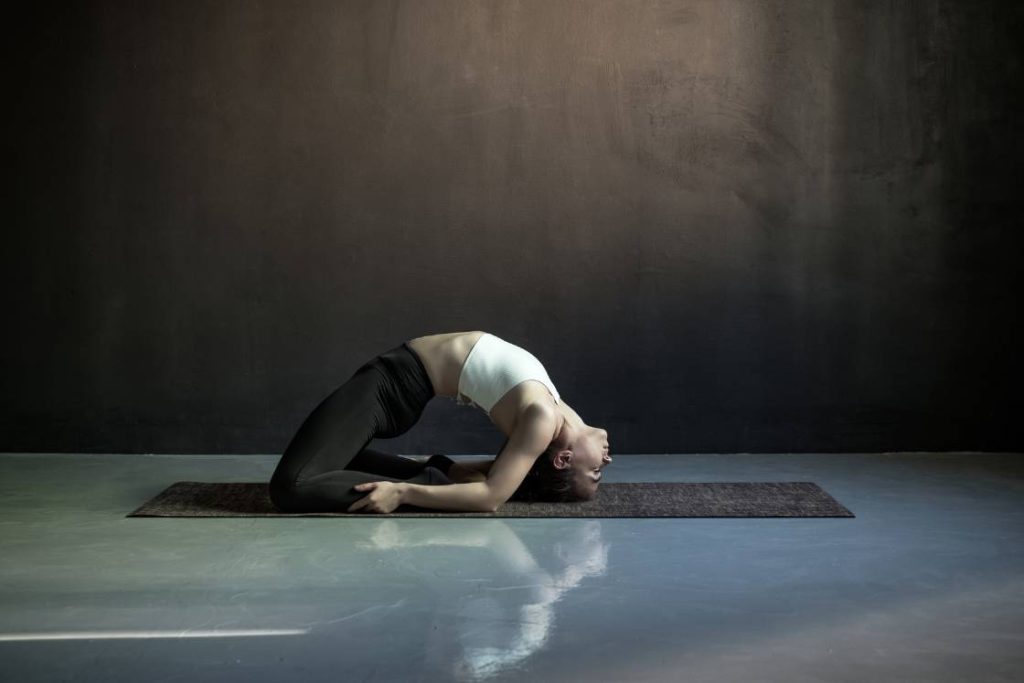
- One easier variation for vajra kapotasana could be performed by placing the palms away from the feet. Just bring your arms overhead with fingertips close to ears. Draw the head as backward as possible and be there. This variation is preferred by beginners.
- If it is difficult to attain the Vajrasana to begin this pose, then, begin with knees on the floor and keeping the thighs perpendicular to the floor (Kneeling position). Then go for back bending with bringing the head and hands to the soles.
- Dove pose can be performed with a slight variation by pregnant women as well. This variation only eliminates the back bending. Sitting on bent knees bring your hands to your waist and then bend your upper back gently.
Therapeutic Use
- Vajra kapotasana stretches the spine that increases the blood flow and provides its flexibility. Hence it serves as a pain reliever for back pain.
- The back bending involved in the posture keeping the abdomen lifted also pressurizes the internal organs. It also promotes bowel movement and prevents constipation.
- Vajra kapotasana is also recommended for rectifying the alignment of the uterus that helps the women to conceive better.
- It also enriches the skin of the practitioner. By enhancing blood flow to the cells, it repairs the dead skin cells and prevents wrinkles. Therefore, it is also effective in fighting the signs of anti-aging.
- This pose also has stress-relieving impacts. By making the spine healthy it also brings enough oxygen to the nervous system. Due to the inversion of the head the blood and nutrient supply to brain cells increases. Hence removes any stress or anxiety.
Dove Pose Benefits
1. Strengthens the heart
In vjara kapotasana, the chest is expanded fully. It also lifts the diaphragm that gently massages and stimulates the heart. It improves cardiovascular efficiency and makes the heart stronger.
2. Releases toxins
The abdominal organs are stimulated while holding the final posture. This benefits the liver and kidney. This eventually helps in enhancing the detoxification process.
3. Strengthens the core
The core muscles also experience the intense stretch. This increases the endurance and leaves the practitioner with stronger core muscles.
4. Stronger arms and legs
Vajra kapotasana actively engages the arms and legs. The muscles around the shoulders, elbows, and wrists bear the entire body weight and strengthen these muscles. Also, the thigh muscles, knees, and lower legs receive enough blood supply and they become flexible.
5. Stretches the hips and groins
The buttocks remain lifted while holding the posture and the muscles are contracted. This improves the blood circulation in the pelvic region and hips muscles to become flexible.
6. Maintains the respiratory system
Dove pose is a great chest opener. It expands the lungs and their capacity to breathe. It also lifts the diaphragm which improves respiration. This makes the pose suitable for better respiration.
7. Energetic benefits
Vajra kapotasana involves the stimulation of three chakras. It makes the practitioner feel energetic by maintaining the flow of the prana (life force) between the heart (Anahata Chakra), throat (Vishuddha Chakra), and third eye (Anjana Chakra).
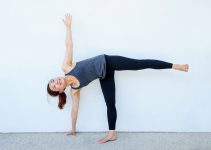
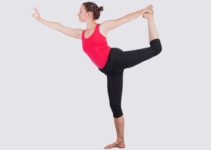
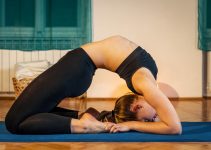
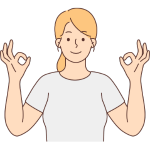
 Oct 24th to 30th
Oct 24th to 30th Learn Mudras
Learn Mudras  Deepen Your Practice
Deepen Your Practice  Find Inner Peace
Find Inner Peace